Research
PIXlab focuses
Heterogeneous integration

Heterogeneous integration combines optical functionalities on chip. So far, multiple materials can be integrated on a common silicon substrate in a scalable way for mass production of photonic integrated devices and circuits. The research originated from the urgent need of III-V material integration on silicon to provide efficient laser sources since silicon is an indirect-bandgap material. Since the early days of development, heterogeneous integration has progressed rapidly by introducing materials with disparate properties and multiple heterogeneously-integrated layers.
Related publications
C. Xiang, W. Jin, D. Huang, M. A. Tran, J. Guo, Y. Wan, W. Xie, G. Kurczveil, A. M. Netherton, D. Liang, H. Rong, and J. E. Bowers, “High-performance silicon photonics using heterogeneous integration,” Journal of Selected Topics in Quantum Electronics, vol. 28, no. 3, pp. 1–15, 2022. link
Laser soliton microcombs
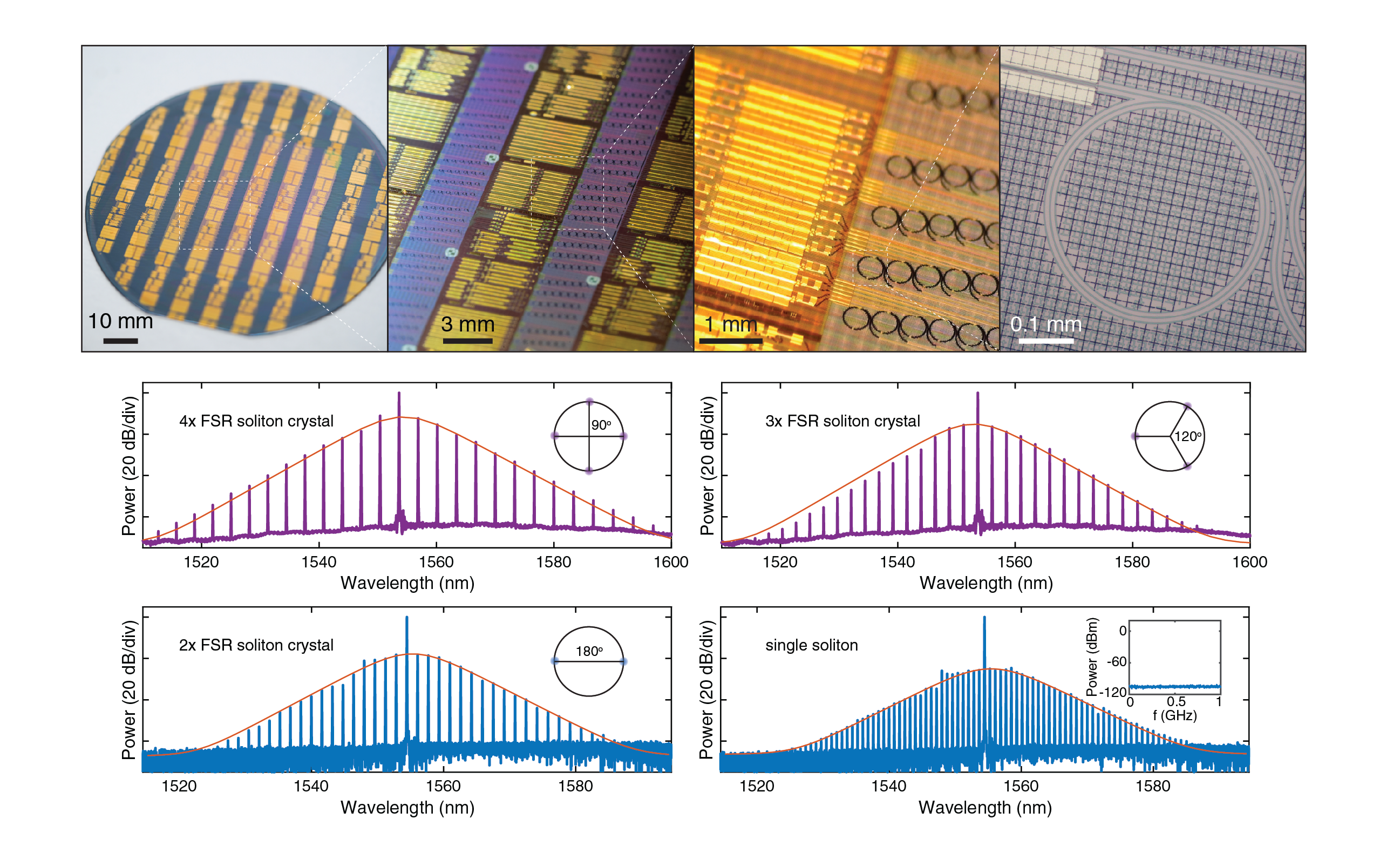
Laser integration with soliton microcombs provides a new route for mutually coherent laser lines on chip. Applications include optical interconnects, microwave photonics, optical metrology and so on. In order to achieve direct laser pumping with nonlinear high-Q microresonator for stable, coherent, low-noise frequency comb state generation, III-V lasers are injection locked with high-Q microresonators. As such, hybrid integration or heterogeneous integration are required. Heterogeneous integration is the most scalable approach for large-scale high-volume production of laser-soliton microcomb modules without the requirement of expensive and time-consuming optical packaging.
Related publications
C. Xiang, J. Liu, J. Guo, L. Chang, R. Wang, W. Weng, J. Peters, W. Xie, Z. Zhang, J. Riemensberger, J. Selvidge, T. J. Kippenberg J. E. Bowers, “Laser soliton microcombs heterogeneously integrated on silicon,” Science, vol. 373, no. 6550, pp. 99–103, 2021. link
Narrow-linewidth lasers
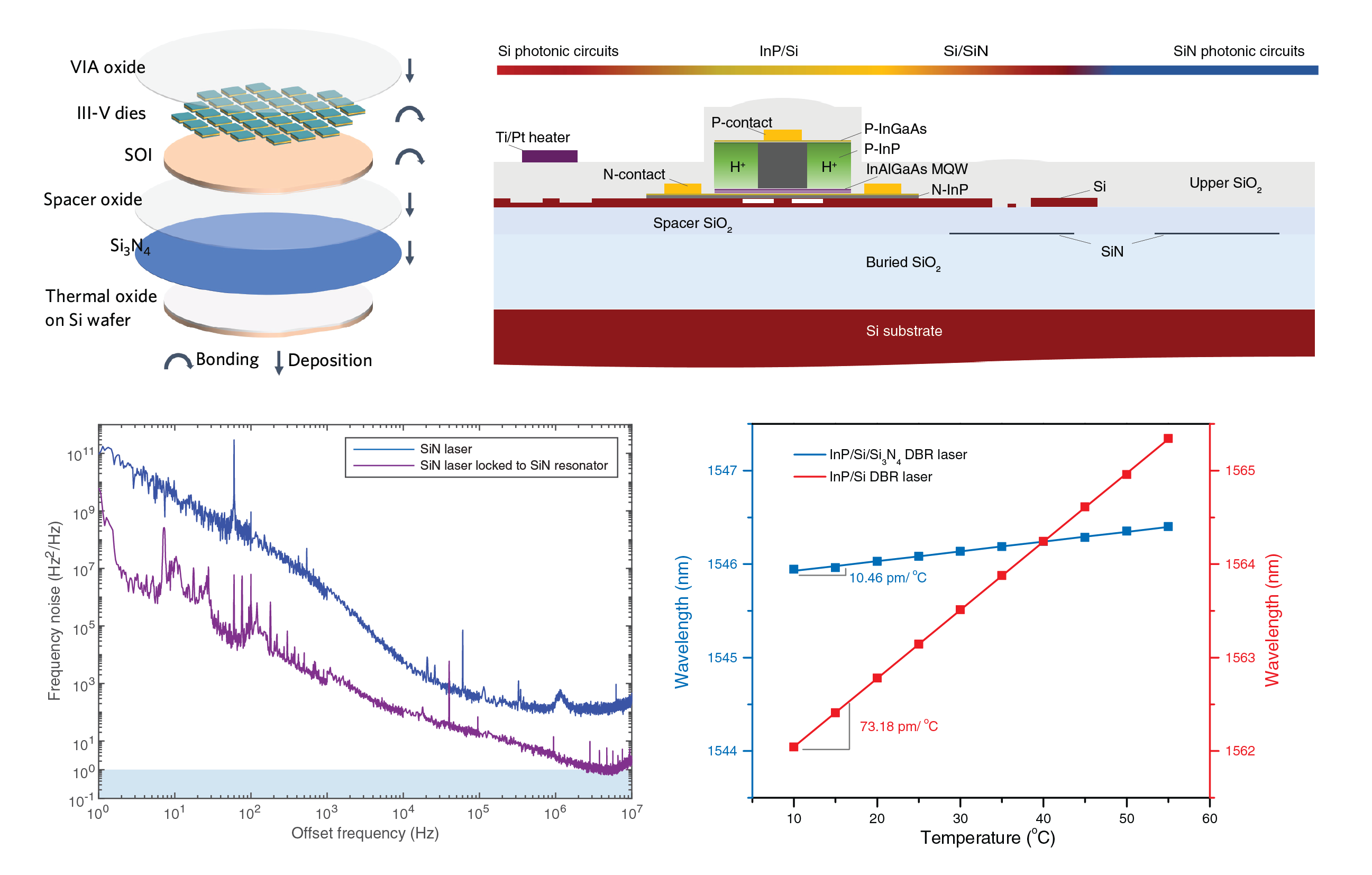
The spectral linewidth is one of the most important characteristics of lasers. Semiconductor lasers are now approaching and exceeding the performance of table-size lasers with a fraction of the size and cost. The progress results from the integration of lossy III-V gain material and low-loss Si or SiN waveguide cavities. State-of-the-art widely tunable narrow linewidth lasers and single-frequency self-injection locked lasers reach around 100 Hz and 40 mHz fundamental linewidth respectively. PDH locking of integrated lasers with ultra low expansion cavity could further reduce the integrated laser linewidth to be around 1 Hz.
Related publications
C. Xiang, W. Jin, J. Guo, J. Peters, M. Kennedy, J. Selvidge, P. Morton and J. E. Bowers, “Narrow-linewidth III-V/Si/Si3N4 laser using multilayer heterogeneous integration,” Optica, 7 (1), 2020. link
C. Xiang, J. Guo, W. Jin, L. Wu, J. Peters, W. Xie, L. Chang, B. Shen, H. Wang, Q. Yang, D. Kinghorn, M. Paniccia, K. J. Vahala, P. A. Morton and J. E. Bowers, “High-performance lasers for fully integrated silicon nitride photonics,” Nature Communications, 12, 6650, 2021. link
Silicon nitride photonics
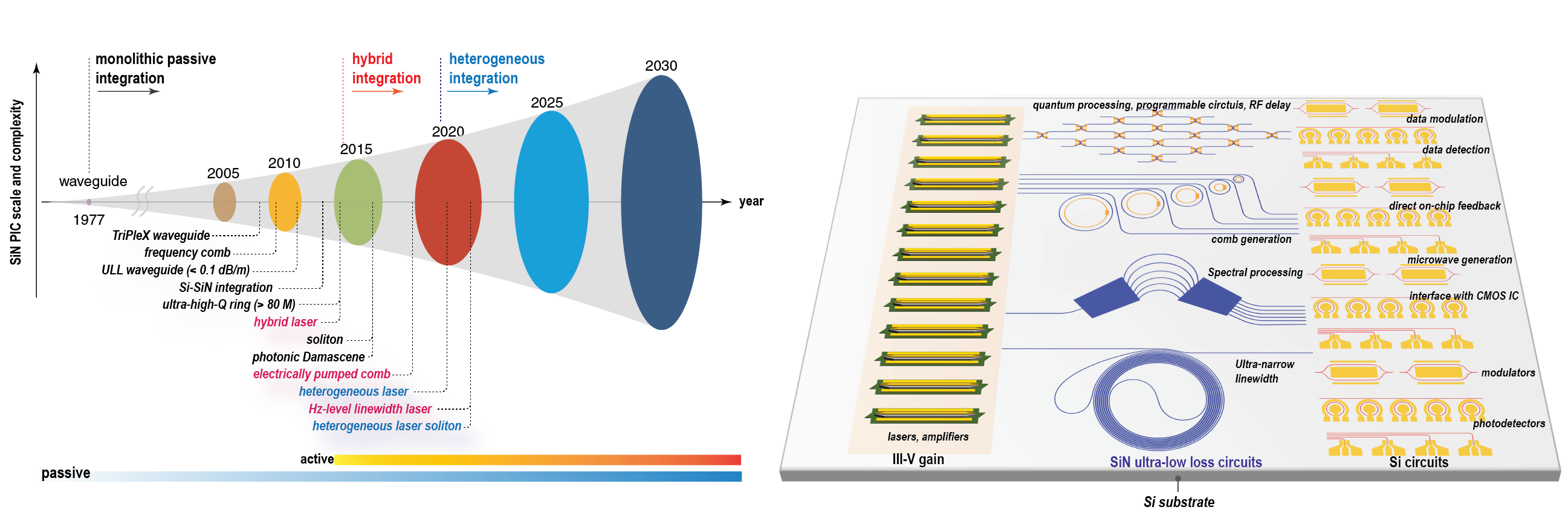
Silicon nitride with ultra low loss used to be a passive-only platform for photonics. Recent developments of heterogeneous integration of SiN with silicon and III-V opens new possibilities for a whole new class of integrated devices and applications. As the leading integrated passive ultra-low-loss platform with broadband transparency and negligible nonlinear loss, silicon nitride finds wide applications in microwave photonics, nonlinear applications and so on. With efficient laser gain and signal modulation, fully on-chip, multi-functional SiN PICs could be possible.
Related publications
C. Xiang, W. Jin and J. E. Bowers, “Silicon nitride passive and active photonic integrated circuits: trends and prospects,” Photonics Research, 10(6), 2022. link
C. Xiang, M. Davenport, J.B. Khurgin, P.A. Morton, J.E. Bowers, “Low-loss continuously tunable optical true time delay based on Si3N4 ring resonators,” Journal of Selected Topics in Quantum Electronics, 24 (4), 2017. link
Copackaged silicon photonics and electronics
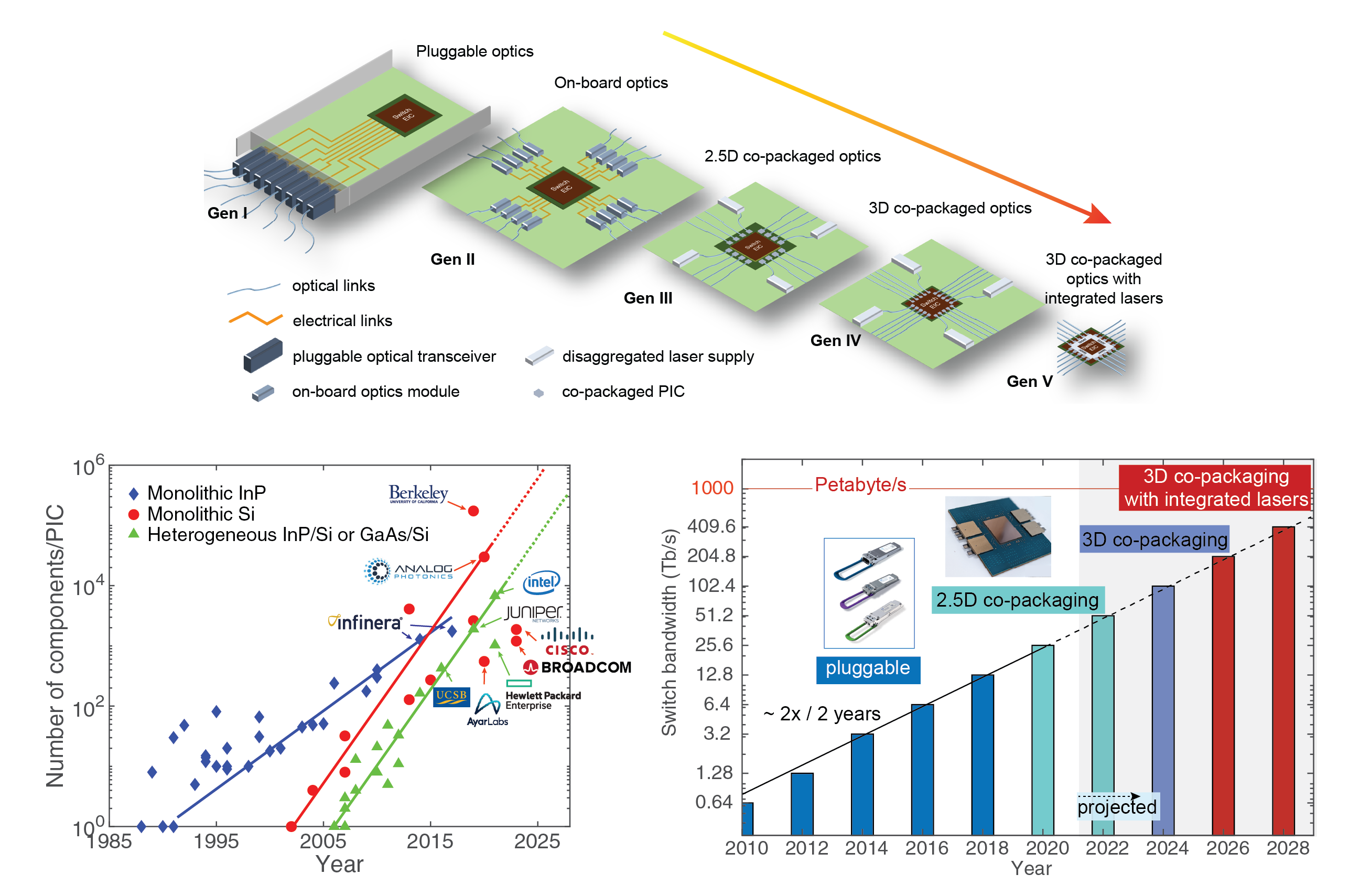
Silicon photonic transceivers are being commercialized for products shipped in millions for datacenter interconnects.. To keep up with the switch bandwidth growth, dense integration of silicon photonics and electronics requires the transition from pluggable optics to copackaged optics. With aggregate data, chip-to-chip interconnects where data movement and processing requires huge amount of power in the electrical domain and scales quickly with interconnect distance, optical I/O appears to be an attractive solution. Moving photonics into the package is promised to be critical in the post-Moore age.
Related publications
N. Margalit, C. Xiang, S. M. Bowers, A. Bjorlin, R. Blum, J. E. Bowers, “Perspective on the future of silicon photonics and electronics,” Applied Physics Letters, 118 (22), 2021. link
Ultra-low-loss waveguides and ultra-high-Q resonators
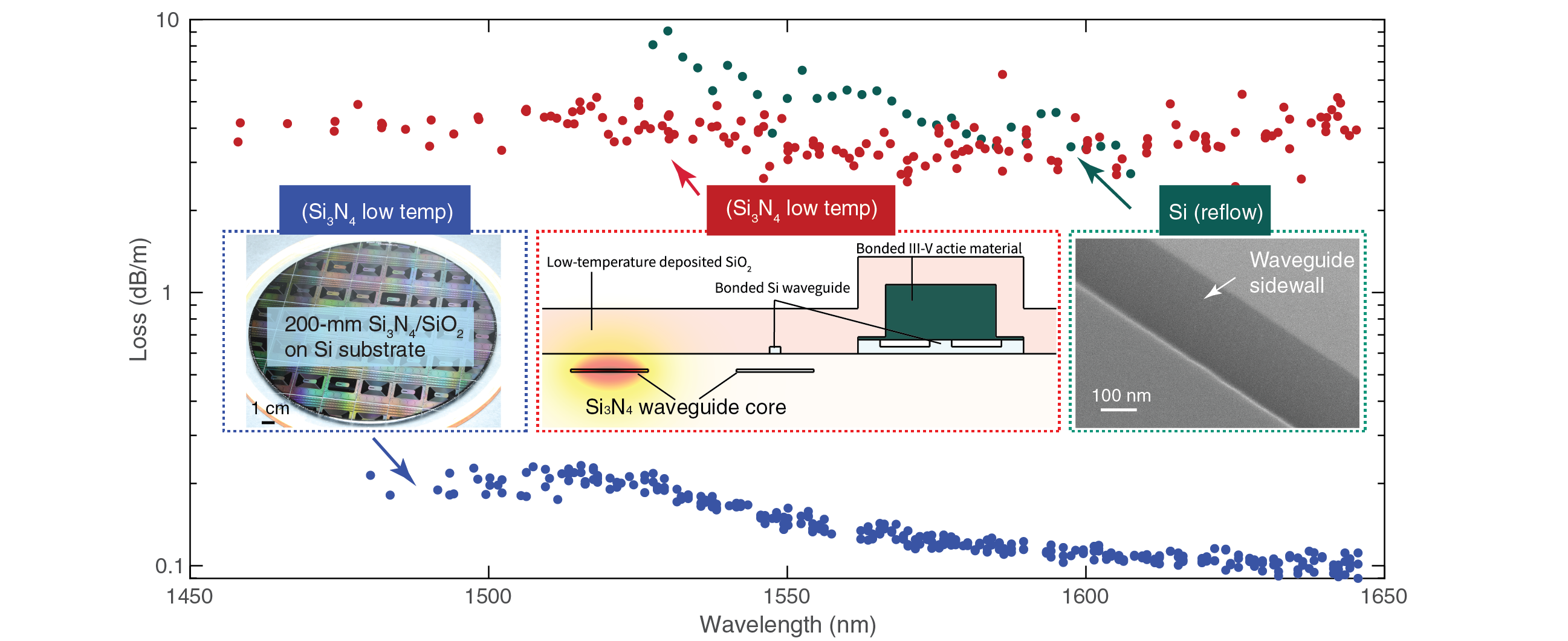
Ultra-low-loss waveguides and ultra-high-Q resonators are the key in improving the performance and scale of on-chip photonic devices. Different material platforms with advanced fabrication technologies are demonstrating remarkable progress in recent years. Overall, ultra-low-loss significantly lowers the nonlinear threshold, increase the signal fidelity, reduce the laser linewidth etc. Fabrication optimization in terms of lithography, etching and annealing within thermal budget lead to significantly lower waveguide loss and resultant ultra-high-Q cavities.
Related publications
C. Xiang, W. Jin, D. Huang, M. A. Tran, J. Guo, Y. Wan, W. Xie, G. Kurczveil, A. M. Netherton, D. Liang, H. Rong, and J. E. Bowers, “High-performance silicon photonics using heterogeneous integration,” Journal of Selected Topics in Quantum Electronics, vol. 28, no. 3, pp. 1–15, 2022. link
W. Xie, C. Xiang, L. Chang, W. Jin, J. Peters, and J. E. Bowers, “Silicon-integrated nonlinear III-V photonics,” Photonics Research, 10(2), 2022. link